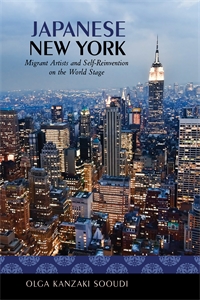Japanese New York: Migrant Artists and Self-reinvention on the World Stage
- About the Book
-
Spend time in New York City and, soon enough, you will encounter some of the Japanese nationals who live and work there—young English students, office workers, painters, and hairstylists. New York City, one of the world’s most vibrant and creative cities, is also home to one of the largest overseas Japanese populations in the world. Among them are artists and designers who produce cutting-edge work in fields such as design, fashion, music, and art. Part of the so-called “creative class” and a growing segment of the neoliberal economy, they are usually middle-class and college-educated. They move to New York for anywhere from a few years to several decades in the hope of realizing dreams and aspirations unavailable to them in Japan. Yet the creative careers they desire are competitive, and many end up working illegally in precarious, low paying jobs. Though they often migrate without fixed plans for return, nearly all eventually do, and their migrant trajectories are punctuated by visits home.
Japanese New York offers an intimate, ethnographic portrait of these Japanese creative migrants living and working in NYC. At its heart is a universal question—how do adults reinvent their lives? In the absence of any material or social need, what makes it worthwhile for people to abandon middle-class comfort and home for an unfamiliar and insecure life? Author Olga Sooudi explores these questions in four different venues patronized by New York’s Japanese: a grocery store and restaurant, where hopeful migrants work part-time as they pursue their ambitions; a fashion designer’s atelier and an art gallery, both sites of migrant aspirations. As Sooudi’s migrant artists toil and network, biding time until they “make it” in their chosen industries, their optimism is complicated by the material and social limitations of their lives.
The story of Japanese migrants in NYC is both a story about Japan and a way of examining Japan from beyond its borders. The Japanese presence abroad, a dynamic process involving the moving, settling, and return to Japan of people and their cultural products, is still underexplored. Sooudi’s work will help fill this lacuna and will contribute to international migration studies, to the study of contemporary Japanese culture and society, and to the study of Japanese youth, while shedding light on what it means to be a creative migrant worker in the global city today.
- About the Author(s)
-
Olga Kanzaki Sooudi, Author
Professor of Anthropology at The University of Amsterdam.
- Reviews and Endorsements
-
- . . . the strength of Sooudi’s book lies in its historical contextualization of the Japanese migration phenomenon. The author draws parallels between contemporary migrants and the modern writers Mori Ōgai, Nagai Kafū, Natsume Sōseki, and the philosopher Kuki Shūzō, who lived abroad in Europe and the us. . . . Sooudi’s multifaceted narrative of Japanese migrants in New York City is like a mirror of Japan and is a way of re-examining Japan from beyond its borders.
—Asian Diasporic Visual Cultures and the Americas - This valuable book contributes not only to our understanding of Japanese migrants to NYC, but in a much broader sense provides the reader with a better understanding of migration and transnational life at a time when millions of people around the world are on the move, driven by multiple causes where the search for self-realisation and artistic fulfilment always plays an important role.
—New Zealand Journal of Asian Studies - The fabric of Japanese New York consists of an intertwining of several different strands. . . . [and] is unlike other works on migration because the phenomenon it describes is unique. Sooudi’s Japanese subjects are neither refugees nor immigrants. They do not leave Japan intending never to return. . . . Adding greatly to the pleasure of reading Japanese New York is a constant flow of characters and stories.
—Pacific Affairs
- . . . the strength of Sooudi’s book lies in its historical contextualization of the Japanese migration phenomenon. The author draws parallels between contemporary migrants and the modern writers Mori Ōgai, Nagai Kafū, Natsume Sōseki, and the philosopher Kuki Shūzō, who lived abroad in Europe and the us. . . . Sooudi’s multifaceted narrative of Japanese migrants in New York City is like a mirror of Japan and is a way of re-examining Japan from beyond its borders.
- Supporting Resources
-










